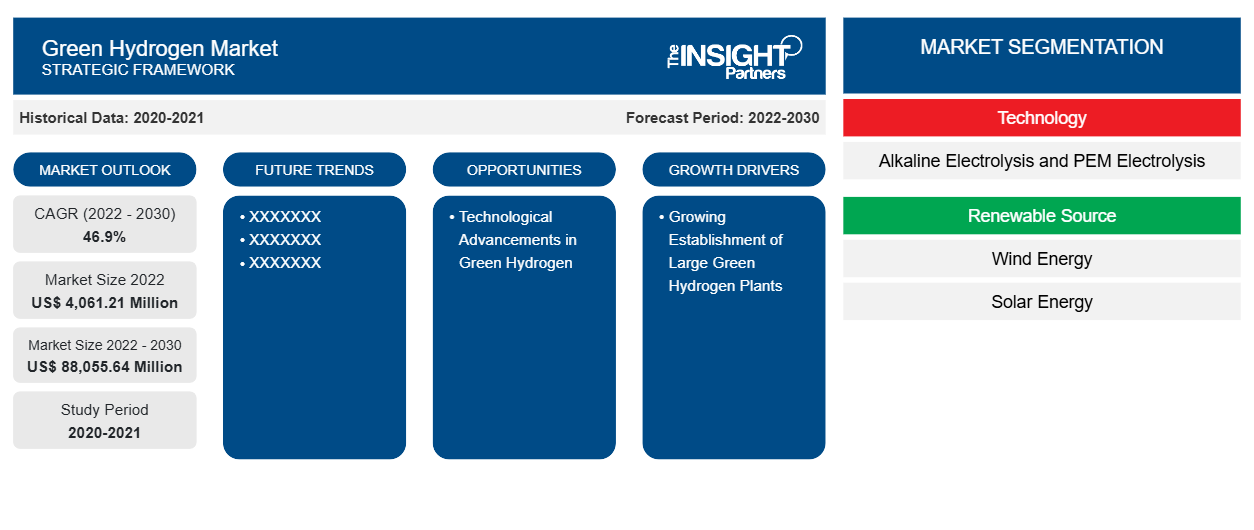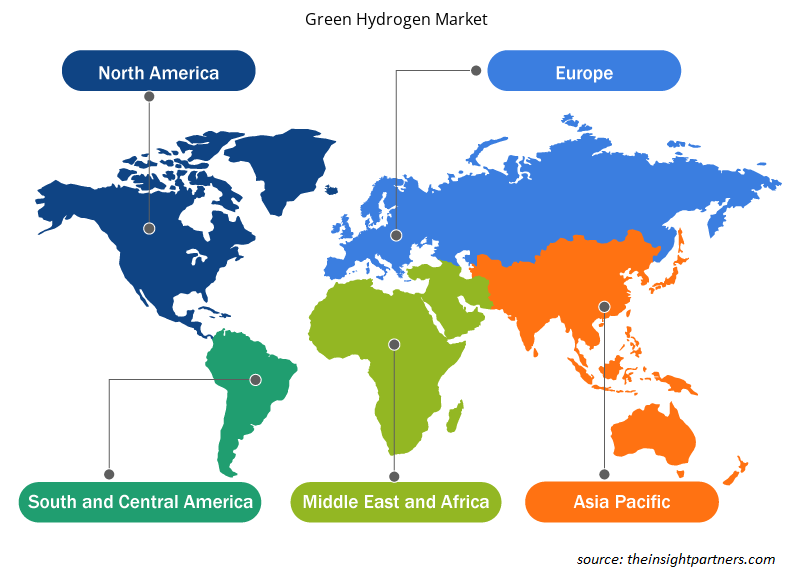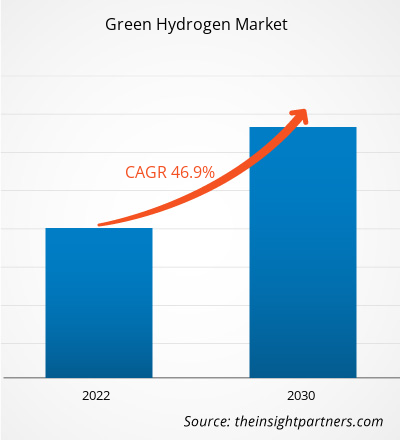La taille du marché de l'hydrogène vert devrait passer de 8,38 milliards de dollars américains en 2024 à 71,31 milliards de dollars américains d'ici 2031 ; elle devrait enregistrer un TCAC de 37,8 % de 2025 à 2031. L'investissement gouvernemental en forte croissance dans les énergies renouvelables devrait rester une tendance clé du marché de l'hydrogène vert.
Analyse du marché de l'hydrogène vert
Partout dans le monde, les gouvernements reconnaissent les avantages de l'hydrogène vert comme solution énergétique propre et durable. Ils prennent des mesures proactives pour soutenir son développement et son déploiement dans divers secteurs. L'accent croissant mis sur la décarbonation et l'atténuation du changement climatique incite les gouvernements à privilégier les investissements dans l'hydrogène vert pour réduire les émissions de carbone. Par exemple, en juin 2022, Protium , l'une des principales entreprises d'hydrogène vert au Royaume-Uni, a fourni des solutions énergétiques complètes à zéro émission nette. Ainsi, l'augmentation des investissements dans les projets d'hydrogène vert devrait créer des opportunités intéressantes de développement du marché dans les années à venir.
Aperçu du marché de l'hydrogène vert
L'électrolyse permet de produire de l'hydrogène vert en séparant les molécules d'eau en oxygène et en hydrogène à l'aide d'électricité. Les avancées technologiques en électrolyse contribuent à améliorer l'efficacité, la rentabilité et l'évolutivité de la production, du stockage et de l'utilisation de l'hydrogène vert. Des conceptions d'électrolyseurs améliorées , des matériaux catalyseurs avancés et des conditions de fonctionnement optimisées sont autant de facteurs susceptibles d'améliorer l'efficacité de la conversion énergétique, de raccourcir les temps de réponse et d'allonger la durée de vie des équipements. En juillet 2023, l'Institut coréen de recherche sur les normes et les sciences ( KRISS ) a présenté une solution potentielle pour un procédé de transport de porteurs durable et efficace, utilisant une photoanode avec un film protecteur, afin de développer la production d'hydrogène vert. Ces avancées élargissent également le champ d'application de l'hydrogène vert. Ainsi, les avancées technologiques associées à l'hydrogène vert devraient stimuler la croissance du marché au cours de la période de prévision.
Personnalisez ce rapport en fonction de vos besoins
Vous bénéficierez d'une personnalisation gratuite de n'importe quel rapport, y compris des parties de ce rapport, ou d'une analyse au niveau des pays, d'un pack de données Excel, ainsi que de superbes offres et réductions pour les start-ups et les universités.
Marché de l'hydrogène vert : perspectives stratégiques

- Obtenez les principales tendances clés du marché de ce rapport.Cet échantillon GRATUIT comprendra une analyse de données, allant des tendances du marché aux estimations et prévisions.
Moteurs et opportunités du marché de l'hydrogène vert
La demande croissante de véhicules à pile à combustible favorise le marché
Les véhicules électriques à pile à combustible ( VEPC ) utilisent l'hydrogène comme carburant et produisent de l'électricité grâce à des piles à combustible. Ils constituent une alternative propre et performante aux véhicules à moteur à combustion interne traditionnels. Face aux efforts déployés par les pays pour réduire leurs émissions de carbone et adopter des modes de transport sobres en carbone , la demande de VEPC augmente à l'échelle mondiale. Par conséquent, divers acteurs du marché s'engagent dans des développements stratégiques, tels que des partenariats, des collaborations et des accords, afin d'améliorer leur offre et de répondre à la demande croissante de VEPC . L'adoption des VEPC renforce le besoin de production d'hydrogène vert, car il constitue la principale source de carburant de ces véhicules.
Implantation croissante de grandes centrales à hydrogène vert : une opportunité sur le marché de l'hydrogène vert
La création d'usines d'hydrogène vert à grande échelle attire des investissements importants des secteurs public et privé. En juin 2023, un groupe d'entreprises a annoncé son intention d'investir 79,75 dollars américains dans un projet d'agrandissement d'une usine de production d'hydrogène et d'une usine de liquéfaction d'hydrogène dans le Queensland, en Australie. Ce groupe comprend Kansai Electric Power Company (Japon), Marubeni Corporation (Japon), Iwatani Corporation (Japon), Keppel Infrastructure (Singapour) et Stanwell Corporation (Australie). L'essor du développement des infrastructures devrait créer un environnement favorable à la mise en œuvre de l'hydrogène vert dans différents secteurs, ce qui devrait offrir des perspectives de croissance aux acteurs du marché au cours de la période de prévision.
Analyse de segmentation du rapport sur le marché de l'hydrogène vert
Les segments clés qui ont contribué à l’élaboration de l’ analyse du marché de l’hydrogène vert sont la technologie, les sources renouvelables et l’utilisation finale.
- Sur la base de cette technologie, le marché de l'hydrogène vert a été divisé en deux catégories : l'électrolyse alcaline et l'électrolyse PEM. Le segment de l'électrolyse alcaline a détenu une part de marché plus importante en 2022.
- En termes de sources renouvelables, le marché a été segmenté en énergie éolienne, énergie solaire et autres. Le segment de l'énergie solaire a dominé le marché en 2022.
- En termes d'utilisation finale, le marché a été segmenté en chimie, énergie, agroalimentaire, médecine, pétrochimie, etc. Le segment de l'énergie a dominé le marché en 2022.
Analyse des parts de marché de l'hydrogène vert par zone géographique
La portée géographique du rapport sur le marché de l'hydrogène vert est principalement divisée en cinq régions : Amérique du Nord, Asie-Pacifique, Europe, Moyen-Orient et Afrique, et Amérique du Sud/Amérique du Sud et centrale.
L'Europe est leader sur le marché de l'hydrogène vert. Plusieurs pays européens, dont l'Espagne, la France, l'Allemagne et le Portugal, ont pris des mesures pour coopérer et construire un pipeline d'hydrogène d'ici 2030. Ce pipeline facilitera le transport d'environ 2 millions de tonnes d'hydrogène par an de ces pays vers la France. Alors que l'Europe cherche à sécuriser son approvisionnement énergétique et à accélérer sa transition vers un avenir neutre en carbone, l'hydrogène vert apparaît comme une ressource vitale et une solution clé pour réduire sa dépendance aux combustibles fossiles et atteindre des objectifs climatiques ambitieux. L'Allemagne, la France, l'Italie et le Royaume-Uni comptent parmi les principaux pays actifs sur le marché de l'hydrogène vert en Europe. Le gouvernement allemand a déjà pris des mesures pour promouvoir l'économie de l'hydrogène, notamment en adoptant une stratégie nationale pour l'hydrogène. Par exemple, en mars 2022, l'Allemagne a annoncé une contribution de 572 millions de dollars américains à une nouvelle économie mondiale de l'hydrogène vert. Il s'agit d'une étape importante dans la promotion de l'adoption et du développement de solutions énergétiques propres dans le monde entier.
Aperçu régional du marché de l'hydrogène vert
Les tendances et facteurs régionaux influençant le marché de l'hydrogène vert tout au long de la période de prévision ont été analysés en détail par les analystes d'Insight Partners. Cette section aborde également les segments et la géographie du marché de l'hydrogène vert en Amérique du Nord, en Europe, en Asie-Pacifique, au Moyen-Orient et en Afrique, ainsi qu'en Amérique du Sud et en Amérique centrale.

- Obtenez les données régionales spécifiques au marché de l'hydrogène vert
Portée du rapport sur le marché de l'hydrogène vert
| Attribut de rapport | Détails |
|---|---|
| Taille du marché en 2024 | 8,38 milliards de dollars américains |
| Taille du marché d'ici 2031 | 71,31 milliards de dollars américains |
| TCAC mondial (2025 - 2031) | 37,8% |
| Données historiques | 2021-2023 |
| Période de prévision | 2025-2031 |
| Segments couverts | Par technologie
|
| Régions et pays couverts | Amérique du Nord
|
| Leaders du marché et profils d'entreprises clés |
|
Densité des acteurs du marché de l'hydrogène vert : comprendre son impact sur la dynamique des entreprises
Le marché de l'hydrogène vert connaît une croissance rapide, portée par une demande croissante des utilisateurs finaux, due à des facteurs tels que l'évolution des préférences des consommateurs, les avancées technologiques et une meilleure connaissance des avantages du produit. Face à cette demande croissante, les entreprises élargissent leur offre, innovent pour répondre aux besoins des consommateurs et capitalisent sur les nouvelles tendances, ce qui alimente la croissance du marché.
La densité des acteurs du marché désigne la répartition des entreprises opérant sur un marché ou un secteur particulier. Elle indique le nombre de concurrents (acteurs) présents sur un marché donné par rapport à sa taille ou à sa valeur marchande totale.
Les principales entreprises opérant sur le marché de l'hydrogène vert sont :
- Air Liquide
- Siemens Énergie
- Cummins Inc.
- Linde Plc
- NEL ASA
- ?rsted A/S
Avertissement : Les entreprises répertoriées ci-dessus ne sont pas classées dans un ordre particulier.

- Obtenez un aperçu des principaux acteurs du marché de l'hydrogène vert
Actualités et développements récents du marché de l'hydrogène vert
Le marché de l'hydrogène vert est évalué en collectant des données qualitatives et quantitatives issues de recherches primaires et secondaires, notamment d'importantes publications d'entreprises, des données d'associations et des bases de données. Voici une liste des évolutions du marché en matière d'innovation, de développement commercial et de stratégies :
- En octobre 2022, NTPC et Siemens Ltd ont signé un protocole d'accord (MoU) pour la démonstration de la co-combustion d'hydrogène mélangé au gaz naturel dans les turbines à gaz Siemens V94.2 installées dans la centrale à gaz NTPC de Faridabad. (Source : Siemens Ltd, communiqué de presse/site web de l'entreprise/bulletin d'information)
- En décembre 2022, Cummins Inc. a fourni un électrolyseur à membrane échangeuse de protons (PEM) de 35 mégawatts (MW) pour la nouvelle usine de production d'hydrogène de Linde à Niagara Falls, dans l'État de New York. (Source : Cummins Inc., Communiqué de presse/Site web de l'entreprise/Bulletin d'information)
Rapport sur le marché de l'hydrogène vert : couverture et livrables
Le rapport « Taille et prévisions du marché de l'hydrogène vert (2020-2030) » fournit une analyse détaillée du marché couvrant les domaines suivants :
- Taille et prévisions du marché de l'hydrogène vert aux niveaux mondial, régional et national pour tous les segments de marché clés couverts par le champ d'application
- Dynamique du marché, comme les moteurs, les contraintes et les opportunités clés
- Tendances du marché de l'hydrogène vert
- Analyse PEST et SWOT détaillée
- Analyse du marché de l'hydrogène vert couvrant les principales tendances du marché, le cadre mondial et régional, les principaux acteurs, les réglementations et les développements récents du marché
- Analyse de l'industrie, du paysage et de la concurrence du marché de l'hydrogène vert, couvrant la concentration du marché, l'analyse de la carte thermique, les principaux acteurs et les développements récents
- Profils d'entreprise détaillés
- Analyse historique (2 ans), année de base, prévision (7 ans) avec TCAC
- Analyse PEST et SWOT
- Taille du marché Valeur / Volume - Mondial, Régional, Pays
- Industrie et paysage concurrentiel
- Ensemble de données Excel
Rapports récents
Témoignages
Raison d'acheter
- Prise de décision éclairée
- Compréhension de la dynamique du marché
- Analyse concurrentielle
- Connaissances clients
- Prévisions de marché
- Atténuation des risques
- Planification stratégique
- Justification des investissements
- Identification des marchés émergents
- Amélioration des stratégies marketing
- Amélioration de l'efficacité opérationnelle
- Alignement sur les tendances réglementaires






















 Obtenez un échantillon gratuit pour - Marché de l'hydrogène vert
Obtenez un échantillon gratuit pour - Marché de l'hydrogène vert